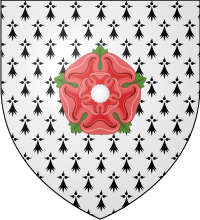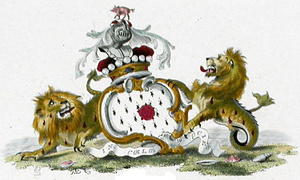Viscount Falmouth
Viscount Falmouth is a title that has been created twice, first in the Peerage of England, and then in the Peerage of Great Britain. The first creation came in the Peerage of England in 1674 for George FitzRoy, illegitimate son of King Charles II by Barbara Villiers. He was created Earl of Northumberland at the same time and in 1683 he was made Duke of Northumberland. However, he left no heirs, so the titles became extinct at his death in 1716.
| Viscountcy Falmouth | |
|---|---|
  Arms of Boscawen: Ermine, a rose gules barbed and seeded proper[1] | |
| Creation date |
|
| Peerage |
|
| First holder |
|
| Present holder | George Boscawen, 9th Viscount Falmouth |
| Heir apparent | Evelyn Arthur Hugh Boscawen |
| Remainder to | Heirs male of the first viscount's body lawfully begotten |
| Subsidiary titles | Baron le Despencer Baron Boscawen-Rose |
| Status | Extant |
| Extinction date | 1716 (first creation) |
| Seat(s) | Tregothnan |
| Former seat(s) | Mereworth Castle[2] |
| Motto | Patience Passe Science ("Patience Surpasses Knowledge") In coelo quies ("In Heaven There is Rest")[2] |

The second creation came in the Peerage of Great Britain in 1720 for Hugh Boscawen (c.1680-1734). He was made Baron Boscawen-Rose at the same time, also in the Peerage of Great Britain. Boscawen had earlier represented Tregony, Cornwall, Truro and Penryn in Parliament and notably served as Comptroller of the Household and Vice-Treasurer of Ireland. His son, the second Viscount, was a General in the Army and also sat as a Member of Parliament for Truro. He later served as Captain of the Yeomen of the Guard. His nephew, the third Viscount, held office as Captain of the Honourable Band of Gentlemen Pensioners from 1797 to 1799. His son, the fourth Viscount, represented Truro in the House of Commons. In 1821 he was created Earl of Falmouth, in the County of Cornwall, in the Peerage of the United Kingdom. He was succeeded by his son, the second Earl. He briefly represented Cornwall West in the House of Commons.
On his death in 1852 the earldom became extinct while he was succeeded in the other titles by his first cousin, the sixth Viscount. He was the son of Reverend John Evelyn Boscawen, second son of the third Viscount. Lord Falmouth married in 1845 Mary Frances Elizabeth Boscawen, 17th Baroness le Despencer (see the Baron le Despencer). In 1872 Viscount Falmouth was listed as one of the top ten landowners in Cornwall, with an estate of 25,910 acres (104.9 km2) or 3.41% of the total area of Cornwall.[3] They were both succeeded by their son, the seventh Viscount and eighteenth Baron, who was a Major-General in the Army. He was allegedly the father of Lady Randolph Churchill's second son, John (1880–1947).[4] Since 1889 the ancient barony of Le Despencer has been a subsidiary title of the viscountcy of Falmouth. As of 2017 the titles are held by his grandson, the ninth Viscount, who succeeded his father in 1962. He served as Lord Lieutenant of Cornwall between 1977 and 1994.
The Conservative politician Robert Boscawen was the younger brother of the ninth Viscount.
The family seat is Tregothnan, near Truro, Cornwall.
Viscounts Falmouth, first creation (1674)
- George FitzRoy, 1st Duke of Northumberland (1665–1716)
Viscounts Falmouth, second creation (1720)
- Hugh Boscawen, 1st Viscount Falmouth (c. 1680–1734)
- Hugh Boscawen, 2nd Viscount Falmouth (1707–1782)
- George Evelyn Boscawen, 3rd Viscount Falmouth (1758–1808)
- Edward Boscawen, 4th Viscount Falmouth (1787–1841) (created Earl of Falmouth in 1821)
Earls of Falmouth (1821)
- Edward Boscawen, 1st Earl of Falmouth (1787–1841)
- George Henry Boscawen, 2nd Earl of Falmouth (1811–1852)
Viscounts Falmouth (1720; reverted)
- Evelyn Boscawen, 6th Viscount Falmouth (1819–1889)
- Evelyn Edward Thomas Boscawen, 7th Viscount Falmouth (1847–1918)
- Evelyn Hugh John Boscawen, 8th Viscount Falmouth (1887–1962)
- George Hugh Boscawen, 9th Viscount Falmouth (born 1919)
Heirs
- The heir apparent is the present holder's son, Hon. Evelyn Arthur Hugh Boscawen (born 1955).
- The heir apparent's heir apparent is his son, Evelyn George William Boscawen (born 1979).
- The heir apparent's heir apparent's heir apparent is his son, Evelyn Ralph Constantine Boscawen (born 2015).
See also
Notes
- Debrett, John (1840). Debrett's Peerage of England, Scotland, and Ireland. revised, corrected and continued by G.W. Collen. pp. 300–302. Retrieved 25 November 2016.
- Lodge, Edmund (1860). The Peerage and Baronetage of the British Empire as at Present Existing. Hurst and Blackett, limited. pp. 230–231. Retrieved 25 November 2016.
- Cahill, Kevin (2001). Who Owns Britain. Canongate Books. ISBN 9780862419127.
- Anne Sebba, American Jennie: The Remarkable Life of Lady Randolph Churchill, Norton, 2008
References
- Kidd, Charles & Williamson, David, eds. (1990) Debrett's Peerage and Baronetage, 1990 edition. New York: St Martin's Press,
- Leigh Rayment's Peerage Pages
External links
- Hansard 1803–2005: contributions in Parliament by George Hugh Boscawen, 9th Viscount Falmouth